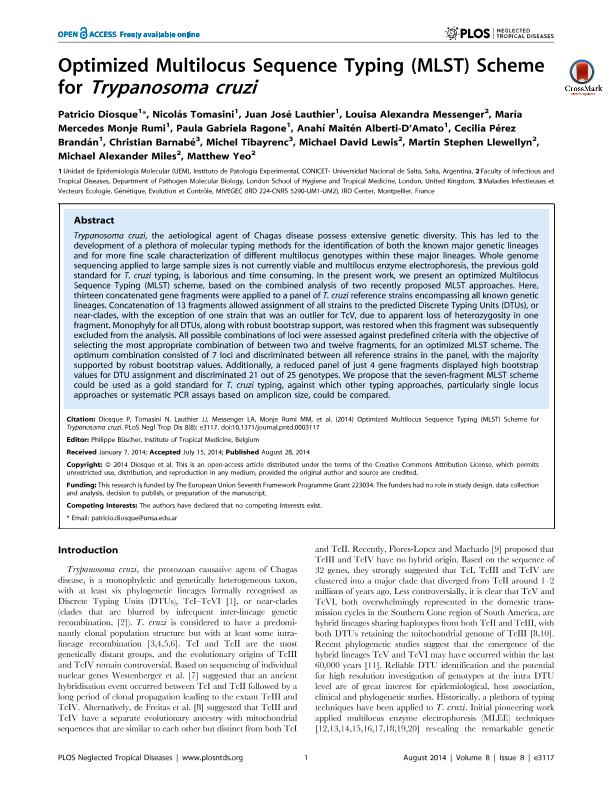Mostrar el registro sencillo del ítem
dc.contributor.author
Diosque, Patricio

dc.contributor.author
Tomasini, Nicolás

dc.contributor.author
Lauthier, Juan José

dc.contributor.author
Messenger, Louisa Alexandra
dc.contributor.author
Monje Rumi, Maria Mercedes

dc.contributor.author
Ragone, Paula Gabriela

dc.contributor.author
Alberti D'Amato, Anahi Maiten
dc.contributor.author
Perez Brandan, Cecilia Maria

dc.contributor.author
Barnabe, Christian
dc.contributor.author
Tibayrenc, Michel
dc.contributor.author
Lewis, Michael David
dc.contributor.author
Llewellyn, Martin Stephen
dc.contributor.author
Miles, Michael Alexander
dc.contributor.author
Yeo, Matthew
dc.date.available
2016-08-11T14:25:16Z
dc.date.issued
2014-08-28
dc.identifier.citation
Diosque, Patricio; Tomasini, Nicolás; Lauthier, Juan José; Messenger, Louisa Alexandra; Monje Rumi, Maria Mercedes; et al.; Optimized multilocus sequence typing (MLST) scheme for Trypanosoma cruzi.; Public Library Of Science; Neglected Tropical Diseases; 8; 8; 28-8-2014; e3117
dc.identifier.issn
1935-2735
dc.identifier.uri
http://hdl.handle.net/11336/7087
dc.description.abstract
Trypanosoma cruzi, the aetiological agent of Chagas disease possess extensive genetic diversity. This has led to the development of a plethora of molecular typing methods for the identification of both the known major genetic lineages and for more fine scale characterization of different multilocus genotypes within these major lineages. Whole genome sequencing applied to large sample sizes is not currently viable and multilocus enzyme electrophoresis, the previous gold standard for T. cruzi typing, is laborious and time consuming. In the present work, we present an optimized Multilocus Sequence Typing (MLST) scheme, based on the combined analysis of two recently proposed MLST approaches. Here,thirteen concatenated gene fragments were applied to a panel of T. cruzi reference strains encompassing all known genetic lineages. Concatenation of 13 fragments allowed assignment of all strains to the predicted Discrete Typing Units (DTUs), or near-clades, with the exception of one strain that was an outlier for TcV, due to apparent loss of heterozygosity in one fragment. Monophyly for all DTUs, along with robust bootstrap support, was restored when this fragment was subsequently excluded from the analysis. All possible combinations of loci were assessed against predefined criteria with the objective of selecting the most appropriate combination of between two and twelve fragments, for an optimized MLST scheme. The optimum combination consisted of 7 loci and discriminated between all reference strains in the panel, with the majority supported by robust bootstrap values. Additionally, a reduced panel of just 4 gene fragments displayed high bootstrap values for DTU assignment and discriminated 21 out of 25 genotypes. We propose that the seven-fragment MLST scheme could be used as a gold standard for T. cruzi typing, against which other typing approaches, particularly single locus approaches or systematic PCR assays based on amplicon size, could be compared.
dc.format
application/pdf
dc.language.iso
eng
dc.publisher
Public Library Of Science

dc.rights
info:eu-repo/semantics/openAccess
dc.rights.uri
https://creativecommons.org/licenses/by/2.5/ar/
dc.subject
Multilocus Sequence Typing
dc.subject
Trypanosoma Cruzi
dc.subject
Scheme of Optimization
dc.subject
Genetic Diversity
dc.subject.classification
Enfermedades Infecciosas

dc.subject.classification
Ciencias de la Salud

dc.subject.classification
CIENCIAS MÉDICAS Y DE LA SALUD

dc.title
Optimized multilocus sequence typing (MLST) scheme for Trypanosoma cruzi.
dc.type
info:eu-repo/semantics/article
dc.type
info:ar-repo/semantics/artículo
dc.type
info:eu-repo/semantics/publishedVersion
dc.date.updated
2016-08-04T18:17:41Z
dc.journal.volume
8
dc.journal.number
8
dc.journal.pagination
e3117
dc.journal.pais
Estados Unidos

dc.journal.ciudad
San Francisco
dc.description.fil
Fil: Diosque, Patricio. Consejo Nacional de Investigaciones Científicas y Técnicas. Centro Científico Tecnológico Salta. Instituto de Patología Experimental; Argentina. Universidad Nacional de Salta; Argentina
dc.description.fil
Fil: Tomasini, Nicolás. Consejo Nacional de Investigaciones Científicas y Técnicas. Centro Científico Tecnológico Salta. Instituto de Patología Experimental; Argentina. Universidad Nacional de Salta; Argentina
dc.description.fil
Fil: Lauthier, Juan José. Consejo Nacional de Investigaciones Científicas y Técnicas. Centro Científico Tecnológico Salta. Instituto de Patología Experimental; Argentina. Universidad Nacional de Salta; Argentina
dc.description.fil
Fil: Messenger, Louisa Alexandra. London School of Hygiene and Tropical Medicine; Reino Unido
dc.description.fil
Fil: Monje Rumi, Maria Mercedes. Consejo Nacional de Investigaciones Científicas y Técnicas. Centro Científico Tecnológico Salta. Instituto de Patología Experimental; Argentina. Universidad Nacional de Salta; Argentina
dc.description.fil
Fil: Ragone, Paula Gabriela. Consejo Nacional de Investigaciones Científicas y Técnicas. Centro Científico Tecnológico Salta. Instituto de Patología Experimental; Argentina. Universidad Nacional de Salta; Argentina
dc.description.fil
Fil: Alberti D'Amato, Anahi Maiten. Consejo Nacional de Investigaciones Científicas y Técnicas. Centro Científico Tecnológico Salta. Instituto de Patología Experimental; Argentina. Universidad Nacional de Salta; Argentina
dc.description.fil
Fil: Perez Brandan, Cecilia Maria. Consejo Nacional de Investigaciones Científicas y Técnicas. Centro Científico Tecnológico Salta. Instituto de Patología Experimental; Argentina. Universidad Nacional de Salta; Argentina
dc.description.fil
Fil: Barnabe, Christian. Institut de Recherche pour le Développement. Maladies Infectieuses et Vecteurs Ecologie, Génétique, Evolution et Contrôle; Francia
dc.description.fil
Fil: Tibayrenc, Michel. Institut de Recherche our le Développement. Maladies Infectieuses et Vecteurs Ecologie, Génétique, Evolution et Contrôle; Francia
dc.description.fil
Fil: Lewis, Michael David. London School of Hygiene and Tropical Medicine; Reino Unido
dc.description.fil
Fil: Llewellyn, Martin Stephen. London School of Hygiene and Tropical Medicine; Reino Unido
dc.description.fil
Fil: Miles, Michael Alexander. London School of Hygiene and Tropical Medicine; Reino Unido
dc.description.fil
Fil: Yeo, Matthew. London School of Hygiene and Tropical Medicine; Reino Unido
dc.journal.title
Neglected Tropical Diseases

dc.relation.alternativeid
info:eu-repo/semantics/altIdentifier/doi/http://dx.doi.org/10.1371/journal.pntd.0003117
dc.relation.alternativeid
info:eu-repo/semantics/altIdentifier/doi/10.1371/journal.pntd.0003117
dc.relation.alternativeid
info:eu-repo/semantics/altIdentifier/url/http://journals.plos.org/plosntds/article?id=10.1371/journal.pntd.0003117
Archivos asociados
